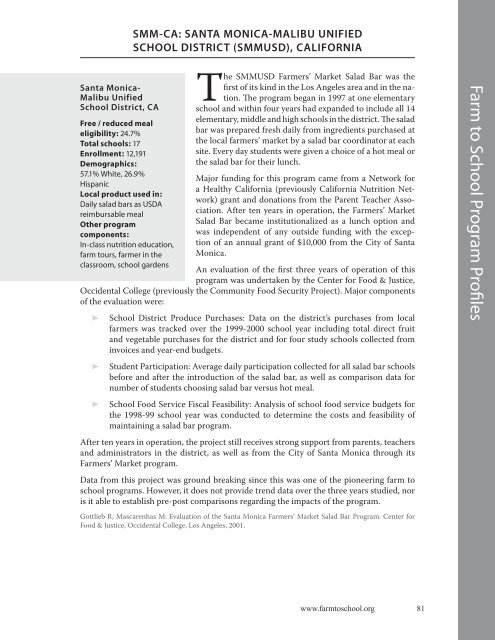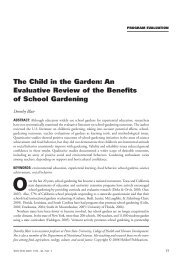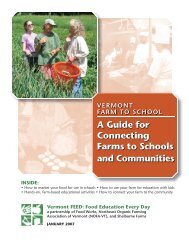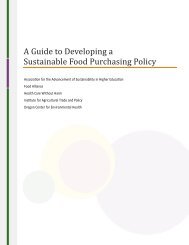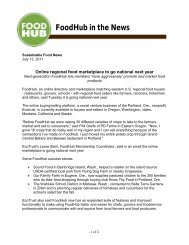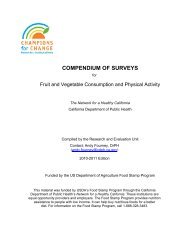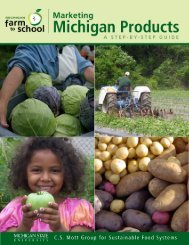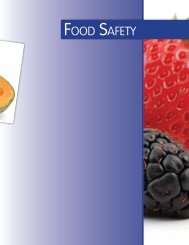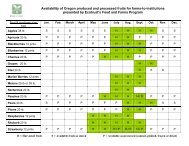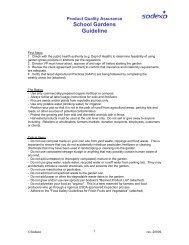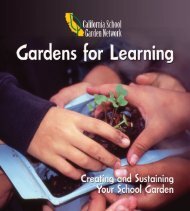eval report cover.indd - New Jersey Farm to School Network Wiki
eval report cover.indd - New Jersey Farm to School Network Wiki
eval report cover.indd - New Jersey Farm to School Network Wiki
Create successful ePaper yourself
Turn your PDF publications into a flip-book with our unique Google optimized e-Paper software.
SMM-CA: SANTA MONICA-MALIBU UNIFIEDSCHOOL DISTRICT (SMMUSD), CALIFORNIASanta Monica-Malibu Unified<strong>School</strong> District, CAFree / reduced mealeligibility: 24.7%Total schools: 17Enrollment: 12,191Demographics:57.1% White, 26.9%HispanicLocal product used in:Daily salad bars as USDAreimbursable mealOther programcomponents:In-class nutrition education,farm <strong>to</strong>urs, farmer in theclassroom, school gardensThe SMMUSD <strong>Farm</strong>ers’ Market Salad Bar was thefi r st of its kind in the Los Angeles area and in the nation.The program began in 1997 at one elementaryschool and within four years had expanded <strong>to</strong> include all 14elementary, middle and high schools in the district. Th e saladbar was prepared fresh daily from ingredients purchased atthe local farmers’ market by a salad bar coordina<strong>to</strong>r at eachsite. Every day students were given a choice of a hot meal orthe salad bar for their lunch.Major funding for this program came from a <strong>Network</strong> fora Healthy California (previously California Nutrition <strong>Network</strong>)grant and donations from the Parent Teacher Association.After ten years in operation, the <strong>Farm</strong>ers’ MarketSalad Bar became institutionalized as a lunch option andwas independent of any outside funding with the exceptionof an annual grant of $10,000 from the City of SantaMonica.An <strong>eval</strong>uation of the first three years of operation of thisprogram was undertaken by the Center for Food & Justice,Occidental College (previously the Community Food Security Project). Major componentsof the <strong>eval</strong>uation were:►►►<strong>School</strong> District Produce Purchases: Data on the district’s purchases from localfarmers was tracked over the 1999-2000 school year including <strong>to</strong>tal direct fruitand vegetable purchases for the district and for four study schools collected frominvoices and year-end budgets.Student Participation: Average daily participation collected for all salad bar schoolsbefore and after the introduction of the salad bar, as well as comparison data fornumber of students choosing salad bar versus hot meal.<strong>School</strong> Food Service Fiscal Feasibility: Analysis of school food service budgets forthe 1998-99 school year was conducted <strong>to</strong> determine the costs and feasibility ofmaintaining a salad bar program.After ten years in operation, the project still receives strong support from parents, teachersand administra<strong>to</strong>rs in the district, as well as from the City of Santa Monica through its<strong>Farm</strong>ers’ Market program.Data from this project was ground breaking since this was one of the pioneering farm <strong>to</strong>school programs. However, it does not provide trend data over the three years studied, noris it able <strong>to</strong> establish pre-post comparisons regarding the impacts of the program.Gottlieb R, Mascarenhas M: Evaluation of the Santa Monica <strong>Farm</strong>ers’ Market Salad Bar Program. Center forFood & Justice, Occidental College, Los Angeles, 2001.Conclusions <strong>Farm</strong> <strong>to</strong> <strong>School</strong> and Program RecommendationsProfileswww.farm<strong>to</strong>school.org 81


